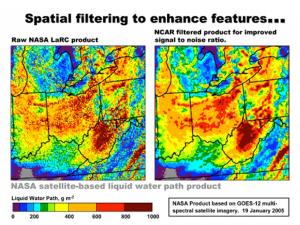
Satellite Applications
Meteorolgical Satellite Data To Enhance Understanding of Atmospheric Processes and Applications

Satellite Applications
Meteorolgical Satellite Data To Enhance Understanding of Atmospheric Processes and Applications
Transitioning Advanced Satellite Observations into Practical Applications
RAL scientists and engineers are continuing work on a number of projects that involve the acquisition and application of meteorological satellite data to enhance understanding of atmospheric processes and applications. These efforts specifically address aviation hazards such as in-flight icing, fog, turbulence, and convective weather over land and over oceans and have made tremendous contributions to safety and efficiency in aviation. These contributions can be directly attributed to stunning advancements in NOAA’s geostationary (GOES) and polar-orbiting (POES) satellites. These satellites provide a continuous stream of environmental data, and have been a boon for operations and researchers, providing high-quality data faster, more often and with better resolution than previous satellites. Pilots, air traffic control and researchers are among many who directly benefit from these advancements.
More Data Than Ever
Weather satellites date back to the 1960s with the launch of the nation’s Geostationary Operational Environmental Satellite (GOES-1). Fast-forward to 2018 with the launch of the newest generation of satellites, GOES-16 and GOES-17, which tout color visible imagery, more frequent scans, and the ability to observe lightning from space. With GOES-16 in place on the eastern U.S. and GOES-17 covering the west, the data they generate are rich, detailed and extremely valuable.
With this bounty of data, RAL experts continue to develop and refine products to assist pilots in flight. These products are improving the forecasting of, for example, oceanic weather, icing conditions, turbulence, low level fog and lightning, conditions that are a bane to pilots.
For example, to help pilots fly long distances over the ocean, RAL scientists have developed the Remote Oceanic Meteorology Information Operational (ROMIO) Demonstration, which is being tested and evaluated by Delta Air Lines, United Airlines and American Airlines during 2018-2019. Supported by the FAA’s Weather Technology in the Cockpit (WTIC) program, ROMIO holds much promise to pilots flying over the vast oceans within the area of GOES-East and GOES-West coverage. It is supplementing the on-board radar data pilots currently refer to, giving them a view of the convection hazards through the entire flight. The two convection products scan the atmosphere every 15 minutes as opposed to every three hours, allowing the pilots to track the same storm from scan to scan.
Also, NCAR scientists and engineers have taken advantage of improved satellite data through the Geostationary Lightning Mapper (GLM) on the GOES-16 satellite and soon on the GOES-17 satellite. This instrument, the first operational lightning mapper flown in geostationary orbit, measures total lightning (in-cloud and cloud-to-ground) activity continuously over the Americas and adjacent ocean regions with near-uniform spatial resolution of approximately 10 km. These lightning measurements are used in ROMIO to help pilots detect and avoid hazardous regions of convection, as the presence of lightning in a storm indicates that the storm has attained at least the minimum updraft strength to threaten aircraft.
These are just two examples of RAL R&D using improved satellite data to benefit the flying public. Weather satellites today are changing and improving how we live. We are safer in the skies, and with more and more people using air travel, we need products such as these to continue to fly with confidence. By tapping into the much-improved satellite data, researchers will continue to develop and refine products addressing these and other aviation weather challenges.
Contact
Ken Stone
Proj Mgr II
